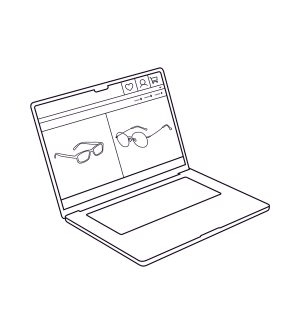ARTICLE
Meeting the Demand for Vision Care with Eyebot
In the US, more than 1 million people are blind, over 3 million have vision impairment, and an additional 8-14 million or more have vision impairment from uncorrected refractive error, such as nearsightedness.
LEARN MORE
Demand for vision care is on the rise
In the US, more than 1 million people are blind, over 3 million have vision impairment, and an additional 8-14 million or more have vision impairment from uncorrected refractive error, such as nearsightedness.(1,2) All of these numbers are estimated to double by 2050.(1) By the same year, nearly half of the world population is expected to be nearsighted.(3) The elderly population in the US is also projected to almost double between 2022 and 2050, driving the demand for eye care.(4)
Vision loss becomes more common with age, and so does the risk for having eye diseases that threaten eyesight, such as cataracts, macular degeneration, diabetic retinopathy, and glaucoma.(5-8) A strong eye care provider workforce is necessary to keep up with the needs of a growing and aging population.
Vision care is facing a provider shortage
Proper vision care is reliant on both ophthalmologists (surgeons) and optometrists. Having an adequate number of both types of eye doctors is essential to meet the needs of the population. Between 2014 and 2020, the US population increased by over 13 million people.(9) Over the same period, the number of optometrists in the US rose from 41,000 to 46,000, while the number of ophthalmologists remained stagnant at around 18,000, and is even expected to decrease by 2,650 doctors, or 12%, by 2035.(10,11)
At this rate, the eye doctor workforce will struggle to meet the demands of the population in the future—in other words, we are facing a shortage of eye doctors. Unfortunately, people across the country and the world are not affected by the provider shortage equally.
In the US today, there are over 40,000 unfilled eye doctor positions, and people living in 12-25% of US counties do not have access to a single optometrist or ophthalmologist.(12-15) In a study of 123 countries, a little over half of the countries met the World Health Organization (WHO)’s target optometrist-to-population ratio of 1:50,000 for developing countries.(16) Only 27% of the surveyed countries met the WHO’s optometrist-to-population target of 1:10,000 for developed countries, including the US and Canada, which had a 1:8,679 combined optometrist-to-population ratio.(16)
Rural communities are hit the hardest, with lack of access to providers and timely care leading to worse vision and overall health.(15,17) Delays to vision care can significantly affect a person’s ability to perform necessary daily tasks, and some patients wait weeks, or even months in the busiest clinics, before they can be seen by an eye doctor.(18-20)
How Eyebot is supporting eye doctors
At Eyebot, we’re leveraging tele-optometry to help both eye doctors and patients adapt to the growing need for vision care. We’ve combined several key components of an in-person visit in our innovative kiosk, giving patients an easy and convenient way to receive a vision test and new eyeglass prescription.
Eyebot’s vision screenings are best suited for healthy users ages 18 to 64. We recommend regular comprehensive eye exams with your eye doctor, especially if you have known eye problems.
During an Eyebot vision screening, you will:
- Answer a few questions about your vision and health
- Read an eye chart to test your vision
- Have your eyes and current glasses (if you have them) measured by the machine
- Preview your test results and prescription
- Learn about any refractive errors you may have
To make vision care accessible to more people, our vision kiosks are placed in convenient locations in the community and can be used at any time. Within 24 hours, all test results are reviewed by one of our tele-doctors, and the official prescription is issued via email. If any abnormal signs are found, we help connect patients to an in-person evaluation.
With Eyebot, eye doctors can reach more patients than ever before, streamline their routine refractive services, and catch undiagnosed eye problems. Together, we can help to fill the provider gap and work towards a more equitable future in vision care.
References:
1. Varma R, Vajaranant TS, Burkemper B, et al. Visual impairment and blindness in adults in the United States: demographic and geographic variations from 2015 to 2050. JAMA Ophthalmol. 2016;134(7):802-809. doi:10.1001/jamaophthalmol.2016.1284
2. Vitale S, Cotch MF, Sperduto RD. Prevalence of visual impairment in the United States. JAMA. 2006 May 10;295(18):2158-63. doi: 10.1001/jama.295.18.2158. PMID: 16684986.
3. Holden BA, Fricke TR, Wilson DA, et al. Global prevalence of myopia and high myopia and temporal trends from 2000 through 2050. Ophthalmology. 2016;123(5):1036-1042. doi:10.1016/j.ophtha.2016.01.006
4. Mather M, Scommegna P. Fact sheet: aging in the United States. Population Reference Bureau. January 9, 2024. Accessed April 17, 2025. https://www.prb.org/resources/fact-sheet-aging-in-the-united-states/
5. Fast facts: 4 in 10 adults at high risk for vision loss. Centers for Disease Control and Prevention. May 15, 2024. Accessed April 17, 2025. https://www.cdc.gov/vision-health/data-research/vision-loss-facts/four-in-10-us-adults-hig h-risk-vision-loss.html
6. Rowe S, MacLean CH, Shekelle PG. Preventing visual loss from chronic eye disease in primary care: scientific review. JAMA. 2004;291(12):1487-1495. doi:10.1001/jama.291.12.1487
7. Flaxman AD, Wittenborn JS, Robalik T, et al. Prevalence of visual acuity loss or blindness in the US: a bayesian meta-analysis. JAMA Ophthalmol. 2021;139(7):717-723. doi:10.1001/jamaophthalmol.2021.0527
8. About common eye disorders and disease. Centers for Disease Control and Prevention. May 15, 2024. Accessed April 17, 2025. https://www.cdc.gov/vision-health/about-eye-disorders/index.html
9. DataBank: World development indicators. World Bank Group. Accessed April 17, 2025. https://databank.worldbank.org/indicator/SP.POP.TOTL/1ff4a498/Popular-Indicators
10. Yang J. Number of eye care professionals in the United States in 2014 and 2020 (in 1,000). Statista. November 30, 2023. Accessed April 17, 2025. https://www.statista.com/statistics/448742/eye-care-professionals-in-the-us-forecast/
11. Berkowitz ST, Finn AP, Parikh R, Kuriyan AE, Patel S. Ophthalmology workforce projections in the United States, 2020 to 2035. Ophthalmology. 2024;131(2):133-139. doi:10.1016/j.ophtha.2023.09.018
12. Job outlook for ophthalmologists in the United States. Zippia. Updated July 23, 2024. Accessed April 17, 2025. https://www.zippia.com/ophthalmologist-jobs/trends/
13. Job outlook for optometrists in the United States. Zippia. Updated July 23, 2024. Accessed April 17, 2025. https://www.zippia.com/optometrist-jobs/trends/
14. American Optometric Association Health Policy Institute. County data demonstrates eye care access nationwide. April 2018. Accessed April 17, 2025. https://www.aoa.org/AOA/Documents/Advocacy/HPI/County%20Data%20Demonstrates %20Eye%20Care%20Access%20Nationwide.pdf
15. Bhatnagar A, Skrehot H, Ahmed M. County-level analysis of eye exam access and utilization in the United States. Ophthalmic Epidemiol. 2024;31(2):152-158. doi:10.1080/09286586.2023.2216286
16. Naidoo KS, Govender-Poonsamy P, Morjaria P, et al. Global mapping of optometry workforce. Afr Vision Eye Health. 2023;82(1), a850. https://doi.org/10.4102/aveh.v82i1.850
17. Elam AR, Tseng VL, Rodriguez TM, et al. Disparities in vision health and eye care. Ophthalmology. 2022;129(10):e89-e113. doi:10.1016/j.ophtha.2022.07.010
18. Blindness and vision impairment. World Health Organization. August 10, 2023. Accessed April 17, 2025. https://www.who.int/news-room/fact-sheets/detail/blindness-and-visual-impairment
19. Lee YH, Chen AX, Varadaraj V, et al. Comparison of access to eye care appointments between patients with medicaid and those with private health care insurance. JAMA Ophthalmol. 2018;136(6):622-629. doi:10.1001/jamaophthalmol.2018.0813
20. How soon can your patients schedule an appointment with you? Review of Optometric Business. Accessed April 17, 2025. https://reviewob.com/how-soon-can-your-patients-schedule-an-appointment-with-you/
